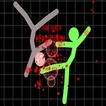
































































































Stickman Games: Unleashing Fun Across Genres and Challenges
In the realm of digital entertainment, stickman games have carved out a unique niche that transcends age and gaming proficiency. These games, characterized by their minimalist stick figure characters, have an undeniable charm that belies the depth and variety they offer. With a few simple lines and circles, developers have unleashed a world of fun that stretches across multiple genres and presents players with an array of challenges.
The beauty of stickman games lies in their simplicity, making them accessible to gamers of all levels. Yet, within this simplicity lies intricate gameplay that demands strategic thinking and quick reflexes. Whether it’s slicing through enemies in a fast-paced action game or carefully planning your next move in a tactical puzzle, stickman games provide a satisfying blend of ease and complexity.
The genre’s versatility is another key to its success. Stickman games cover a broad spectrum, from side-scrolling adventures and sports simulations to role-playing games and tower defense strategies. This diversity ensures that there’s a stickman game for every type of player, whether you’re looking for a casual distraction or a more engaging experience.
Moreover, the stick figure motif has proven to be a perfect canvas for creativity. Developers have taken this rudimentary concept and built expansive worlds, compelling storylines, and innovative mechanics that keep players coming back for more. The stickman may be a simple design, but the games it stars in are anything but basic.
In conclusion, stickman games are a testament to the idea that sometimes less is more. They demonstrate that with a little imagination, even the most basic of graphics can give rise to a universe of entertainment, proving that fun doesn’t need to be complex—it just needs to be engaging.
Stickman Stickman: The Simple Joy of Stick Figure Gaming
At the heart of stickman games is the stick figure, a character composed of lines and dots that has become an icon of simplicity in gaming. This unassuming protagonist offers a blank slate for imagination, allowing players to project their own stories and personalities onto the game. The simplicity of the design means that anyone can pick up and play without being overwhelmed by complex visuals or backstories.
The appeal of stickman games is universal. They tap into the fundamental joy of play that is not hindered by language barriers or cultural differences. The rules are straightforward, the objectives clear, and the controls intuitive. This ease of understanding makes stickman games a welcoming gateway into the world of gaming for novices, while still providing enough depth to keep seasoned gamers engaged.
Developers have leveraged the stick figure’s simplicity to craft games that are rich in creativity and variety. They have pushed the boundaries of what can be done with minimal graphics, proving that gameplay is king. From navigating obstacle-laden courses to solving intricate puzzles, the stick figure becomes a hero in a vast array of settings and scenarios.
The stickman’s versatility is its strength. It can be a warrior, an athlete, a builder, or a thinker. This chameleon-like ability to adapt to different gaming genres is what keeps players intrigued. The stick figure’s world is limited only by the imagination of the creators and the players themselves, resulting in an ever-expanding universe of stickman games that continue to surprise and delight.
In essence, stickman games celebrate the pure joy of gaming. They remind us that at the end of the day, it’s not the sophistication of the graphics that matters, but the quality of the play. Stickman games stand as a testament to the enduring power of simple fun.
Game of Stickman: Strategic Gameplay and Tactical Decisions
In the world of stickman games, the art of strategy plays a pivotal role, transforming seemingly simple scenarios into arenas of tactical warfare. These games challenge players to think several moves ahead, blending the minimalist art style with complex strategic elements. The stick figure, often seen commanding armies or constructing defenses, becomes the centerpiece of a cerebral battleground where every decision counts.
Resource management is a cornerstone of this strategic experience. Players must judiciously allocate limited resources, be it troops, materials, or time, to outmaneuver their opponents. The stark visuals of stickman games strip away any distractions, focusing the player’s attention on the pure strategy underlying the gameplay. This emphasis on tactics encourages players to develop critical thinking and problem-solving skills, as they must adapt to ever-changing situations with limited visual cues.
The simplicity of stick figures also allows for a clear representation of game mechanics, making it easier for players to grasp complex systems. Whether it’s capturing territories, engaging in diplomacy, or building an impenetrable fortress, the actions are straightforward yet profound. The strategic depth in these games often lies not in the graphics or story, but in the gameplay itself, offering a rich and rewarding experience for those who delve into its subtleties.
Moreover, stickman games often incorporate a variety of challenges that require tactical precision. From setting up the perfect ambush to crafting a long-term strategy for victory, these games provide a playground for the tactically minded. The minimalist design belies the intricate dance of decision-making and foresight needed to triumph.
In conclusion, stickman games offer a unique blend of simplicity and complexity, where the strategic gameplay and tactical decisions elevate the stick figure from a mere doodle to a mastermind of virtual conquests. It’s a genre where the depth of play comes not from ornate graphics, but from the elegant ballet of the mind’s own devising.
Stickman Man: Mastering Movement and Physics-Based Challenges
In the kinetic world of stickman games, mastering movement is paramount. These games often hinge on physics-based challenges, where the elegance of motion and the laws of gravity play central roles. Players must navigate their stick figure through a gauntlet of obstacles, harnessing momentum and precision to overcome each level’s demands.
The simplicity of the stick figure belies the sophistication required to control it. A flick of the wrist or a timely jump can mean the difference between success and failure. The physics in these games are not just a backdrop but a core component of the gameplay. Players learn to judge distances, anticipate the arc of a jump, and understand the interplay between speed and trajectory.
This genre of stickman games turns the act of movement into a puzzle. Swinging from ropes, leaping across chasms, and sliding under hazards require a deft understanding of physics. Each action must be calculated, as the natural forces within the game world are unforgiving. Success in these games is a testament to a player’s ability to meld intuition with the digital laws of motion.
The challenges presented are not just tests of reflexes but also of patience and practice. As players progress, the levels increase in complexity, introducing new mechanics and obstacles that push the boundaries of their mastery over movement. The joy of these games lies in the satisfaction of perfectly executed maneuvers, the fluid dance between the player’s intentions and the character’s actions on screen.
In essence, stickman games that focus on physics-based challenges offer a playground for those who revel in the art of movement. They demand precision and reward finesse, turning the simple act of moving a stick figure into an exhilarating experience that captivates and challenges.
Stickman Game: Humor and Parody in Stick Figure Narratives
Stickman games often serve up a generous helping of humor and parody, infusing their simple lines with a comedic spirit that resonates with a wide audience. The narratives in these games frequently poke fun at themselves and the gaming industry, leveraging the stick figure’s unassuming appearance to deliver satire and wit. This lighthearted approach to storytelling adds a layer of enjoyment that complements the gameplay, making these games not just a test of skill but also a source of laughter.
The humor in stickman games is accessible and often slapstick, capitalizing on the absurdity of a stick figure performing heroic feats or surviving outrageous situations. The incongruity between the character’s basic form and the complex or exaggerated scenarios they find themselves in creates a natural comedic contrast. This juxtaposition is a fertile ground for humor, where the simplest of visual gags can elicit a chuckle or even a belly laugh.
Parody plays a significant role in these narratives, with stickman games frequently lampooning popular game genres and tropes. By imitating and exaggerating the characteristics of well-known genres, stickman games offer a playful critique that is both entertaining and insightful. This satirical edge not only adds depth to the games but also engages players on a different level, as they recognize and appreciate the clever twists on familiar themes.
In conclusion, the humor and parody found in stickman games are essential ingredients that spice up the experience. They transform what could be a straightforward gaming session into a lively and amusing adventure. By not taking themselves too seriously, stickman games invite players to join in on the joke, creating a shared sense of fun that is as infectious as it is endearing.